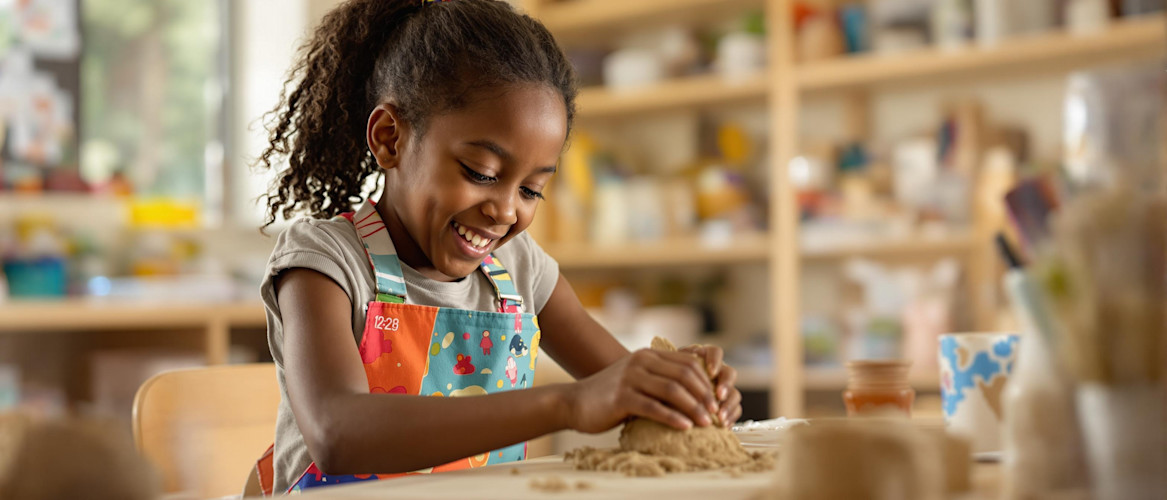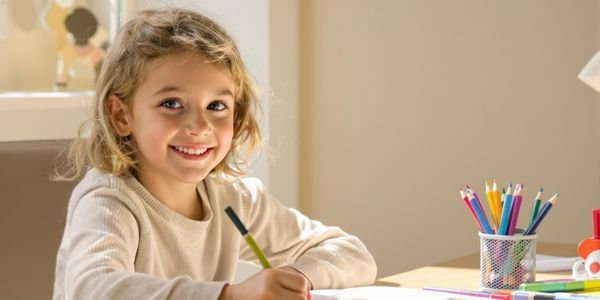When children follow their natural curiosity, meaningful learning happens. Montessori learning is an educational approach that builds on this simple truth. Discovered by Dr. Maria Montessori while observing how children naturally gather knowledge through exploration, her child-centered method resonates with families seeking education that feels natural and purposeful.
The strength of Montessori-inspired education lies in its respect for each child's development and interests. Children work at their own pace, choosing materials that spark their curiosity. This natural alignment with learning styles makes Montessori principles valuable for home education.
At Outschool, we honor and support the learning style you choose for your child with interest-based live and self-paced classes, tailored to the Montessori home environment.
Montessori learning explained
Montessori learning builds on children's natural curiosity and drive to explore their world. When a child measures ingredients for baking, arranges books by size, or practices writing letters in sand, they're developing skills through hands-on discovery. Studies show this self-directed approach helps build strong problem-solving abilities and maintains children's natural enthusiasm for learning.
In home learning spaces, families can create distinct areas for different activities: a math corner with counting materials, a reading nook with varied books, or a practical life station for activities like pouring, sorting, or caring for plants.
Parents become learning partners in the Montessori method, ready to help when needed while giving space for independent discovery. Simple activities like arranging flowers or folding laundry become opportunities for developing coordination, concentration, and confidence.
This approach creates a peaceful learning rhythm where children feel empowered to explore and grow at their own pace.
Why Montessori appeals to families: Real benefits for learners
The benefits of Montessori learning shine brightest when children have space to grow at their own pace. Parents who utilize these principles at home see remarkable changes in how their kids learn and grow together.
- Kids take charge of their learning journey: When children pick activities that light them up, they stay focused and excited to learn more.
- Real-world skills bloom naturally: Making breakfast, organizing art supplies, or tending to plants gives children a sense of pride and capability. These everyday moments become opportunities for joyful learning.
- Social skills grow beautifully: Studies show that as children work and play together, they learn to share ideas, solve problems, and support each other. Multi-age learning also creates natural moments for teaching and helping others.
- Learning becomes a family adventure: Parents shift from giving directions to discovering alongside their children, creating deeper bonds and more peaceful days.
- Children build unshakeable confidence: As kids master new skills at their own speed and make meaningful choices, they develop trust in their abilities and excitement for new challenges.
Montessori at home: Simple ways to get started
When most parents hear “Montessori,” they picture a specialized classroom with trained teachers and carefully arranged materials. But the heart of the Montessori method, child-led learning, hands-on experiences, and respect for each learner’s pace, fits beautifully into many homeschooling approaches families are already exploring.
With a few thoughtful shifts, it’s absolutely possible to bring Montessori principles into your home. Here’s how you can get started:
1. Create a space that supports independence
Choose a calm, uncluttered area where your child can focus. Keep materials on low shelves so they can reach what they need without asking. A few well-chosen options are better than an overwhelming collection. Rotating books or activities every few weeks can keep things feeling new.
Pro tip: Try carving out small zones: maybe a cozy spot for reading, a mat for floor work, or a tray table for art and practical life tasks.
2. Weave learning into daily life
Montessori emphasizes everyday activities as rich learning opportunities, and there are plenty of these at home! Invite your child to help rinse produce or sort clean laundry. Tasks like these build real skills, coordination, focus, sequencing, and give your learner a sense of purpose and contribution.
Pro tip: Child-sized tools can make these jobs feel even more accessible and empowering.
3. Choose materials that invite exploration
Montessori learning is hands-on by design. Look for simple, open-ended tools made of natural materials (puzzles, sandpaper letters, or pouring sets, for example). These materials often teach one concept at a time and include built-in ways for children to check their work. Introduce them slowly and with intention. A quiet demonstration can go a long way in helping your child explore with confidence.
4. Let your child’s interests guide the day
Montessori learners thrive when they’re given time and space to follow what they enjoy. Rather than rushing through a schedule, observe what your child is drawn to and reserve space in the day for deep, uninterrupted focus. When they show readiness for a new challenge, gently offer something new to explore. This slow, steady approach helps build intrinsic motivation and lifelong learning habits.
5. Find your learning community
Connection matters. Whether it’s an online class led by a Montessori-aligned teacher or a backyard playdate with other homeschool families, these experiences offer something valuable. Online learning can spark fresh ideas and allow your child to interact with peers who share their interests. Local meetups, like nature walks or shared project days, create space for collaboration and social growth in ways that still honor a child-led approach.
Frequently Asked Questions About Montessori Learning
Bringing Montessori methods into your home learning environment opens up exciting possibilities for child-led education. Here are practical answers to help you create an engaging Montessori-inspired learning space that works for your unique family.
How do I start Montessori homeschooling without special materials?
Begin with everyday household items to create learning opportunities like measuring cups for math, sorting laundry for classification skills, or gardening tools for practical life skills. Remember, Montessori is about the approach to learning rather than specific products, so start with what you have and build gradually.
How do I create a learning space that encourages independence?
Make your child's materials accessible by using low shelves and organizing items in clear containers. A child-sized table, a few carefully chosen activities, and a designated space for art or reading can create an inviting environment where learning happens naturally.
What's my role as a parent in Montessori learning at home?
Think of yourself as a supportive guide rather than a traditional teacher. Observe your child's interests, prepare engaging activities, and step back to let them explore independently. Your presence should be encouraging but not intrusive, available when needed but allowing space for discovery.
How can I balance structure and freedom in our daily routine?
Create a flexible rhythm to your day with predictable blocks for different types of activities. For example, mornings might include focused learning time where children choose from prepared activities, followed by outdoor exploration, and then creative projects in the afternoon. This provides structure while still centering child-led choice.
How can I adapt Montessori for multiple ages at home?
Set up activity zones that can engage different age levels simultaneously. Younger children might practice pouring water while older ones conduct simple science experiments in the same space. Encourage older children to become mentors, teaching skills to younger siblings while reinforcing their own learning.
Supporting your child's Montessori learning
Montessori learning centers on independence, hands-on exploration, and the freedom to move at your own pace. It’s a method that honors each child’s natural curiosity and supports deep, focused learning through purposeful activities. With a strong foundation in real-world skills and self-direction, Montessori helps kids grow into confident, capable learners.
Outschool makes it easy to bring this approach into your home. Our Montessori-inspired classes are led by teachers who understand how to guide children with care and intention. You’ll find flexible, engaging options that fit your family’s schedule, designed to spark curiosity and support your child’s unique path forward.


.svg)
.svg)







